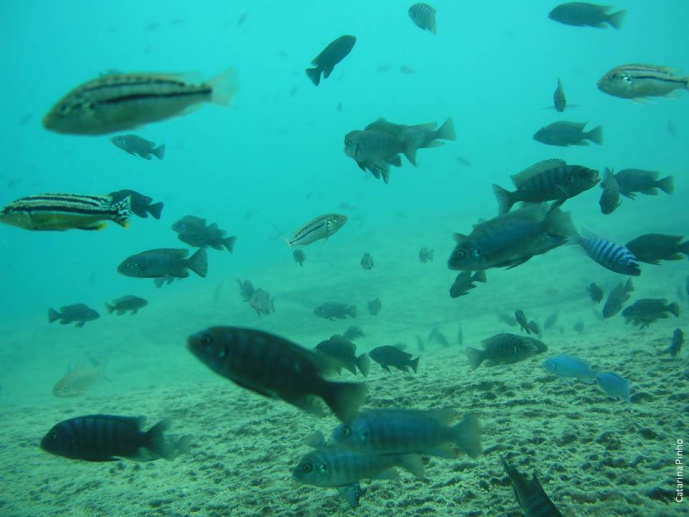Divergence and speciation in Lake Malawi cichlids
Understanding the mechanisms that lead to divergence of populations and, ultimately, to the formation of species is one of the fundamental goals of evolutionary biology. Traditionally, most of the work has focused on the allopatric mode of speciation, in which natural selection acts against gene flow as a consequence of species divergence and thus contributes indirectly to the differentiation. In the framework of sympatric or parapatric speciation, however, it is likely that natural or sexual selection directly promotes divergence through mechanisms such as, for example, ecological specialization or changes in mating preferences. Cichlid fish species of Lake Malawi represent a well known example of explosive speciation in which traditional allopatric processes alone cannot explain the existing diversity.
There is evidence suggesting that divergent selective forces acting on the feeding apparatus or male nuptial color may have promoted differentiation of species in parapatric or even sympatric conditions. In this context, gene flow may have occurred throughout the process of divergence and probably still does. A key question is, then: what mechanisms allow species to co-occur without competitive exclusion and despite ongoing gene flow? A direct way to approach this problem is to investigate which traits differ among sympatric species and their ecological relevance. However, studies that have addressed character displacement in cichlid species focus mostly on divergence of male breeding coloration.
These traits are rapidly evolving and likely to have contributed for the acquisition of reproductive isolation, but divergence in these traits alone cannot account for the coexistence of so many congeneric species within a small area. Other factors than male coloration (e.g. trophic specialization) are therefore likely to have played a role in species divergence and maintenance. A second shortcoming of traditional approaches to the study of cichlid speciation is the reliance on a priori species definitions; since species identification is usually difficult, investigators tend to bias their samples towards typical individuals, overlooking much of the phenotypic variation that exists and incompletely sampling populations. Such biased sampling schemes may difficult the identification of traits that primarily differ among populations and may affect our impressions on how species appear and are maintained.
The proposed research will take an unusual approach to study species divergence, by doing so independently of species designations. Rather than focus on breeding males we will sample uniformly without regard to sex or color (or other traits, such as territorial or feeding behavior). Because the different genera of Malawi cichlids are readily recognized on the basis of head shape we can collect fish of a particular genus, without regard to species or sex. Samples can also be collected without regard to feeding and territorial behaviors or preferred microhabitats. Similarly we can include fish of atypical coloration and that may be hybrids.
A wide array of phenotypes will be recorded for all sampled fish, including photographs under a standard protocol, and a tissue sample (fin clip) will be taken. Genotyping will be done for a large number of short tandem repeat (STR) loci and single nucleotide polymorphism (SNP) loci. The genetic data, considered separately from the phenotypic data, will reveal the populations and how panmictic they are, as well as the presence of intermediate (i.e. hybrid) individuals if they occur. Similarly, for each of the phenotypes assayed we will determine the extent to which multiple clusters are present, and how distinct they are.
With ‘populations’ identified separately on the basis of genetics and for phenotypes, we can overlay the phenotype-based clusters on to the genetic clusters. The contrast between these two independently generated assessments of population status leads to two important questions: 1. What is the level of agreement between genetic and phenotype-based clusters? and 2. Which phenotypes exhibit clustering that most strongly correspond to the genetic groups? Those phenotypic traits that correspond closely to the genetic groups and that exhibit strongly disjunct patterns are likely to lie on gradients of strong differential natural selection that help to maintain the distinction between the species. By determining phenotype/genotype correspondence, and phenotypic distinctiveness, we can generate hypotheses of the kinds of traits at which selection has acted to form or maintain these species.
Jody Hey, R. Estelle Capoccia, Vera Maria Varela Cardoso



